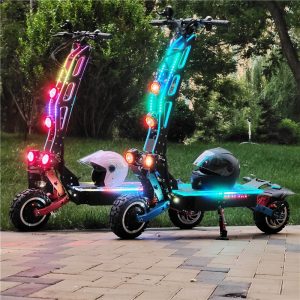Electric scooters: Reshaping the future of urban transportation
Electric scooters, also known as electric scooters, electric balance bikes or electric unicycles, are an emerging form of personal transportation. Their simplicity of design, ease of operation, and energy efficiency have resulted in their rapid and widespread acceptance around the world. This article will delve into the history of e-scooters, how they work, their application areas, and their impact on the future of urban transportation.
The history of electric scooters
The concept of electric scooters is not new, with prototypes dating back to bicycles and motorcycles in the late 19th century. However, the birth of the modern electric scooter can be traced back to a small number of innovators in the early 2000s who saw the potential of electric scooters as a new form of personal transportation. Since then, the design and functionality of electric scooters have changed significantly into the styles we know today.
How electric scooters work
The core of an electric scooter is an electric motor, which converts electrical energy into mechanical energy to drive the scooter forward. Most electric scooters use two foot pedals to control speed and direction. Some advanced models are also equipped with electronic stability systems that can help users maintain balance on various road surfaces.
Application areas of electric scooters
E-scooters were originally used primarily in urban environments as a means of traveling short distances. They are especially popular on congested city streets because they can easily weave between cars and sidewalks. However, with the advancement of technology and changes in user needs, electric scooters are now beginning to be used in more fields. For example, some companies have begun using e-scooters as a means of transportation for employees or as part of a rental service. In addition, electric scooters are also used in leisure activities such as skateboarding and off-road riding.
The impact of electric scooters on future urban transportation
The emergence of electric scooters has undoubtedly had a profound impact on urban transportation. First, they provide a new way to travel, allowing urban residents to choose greener and more convenient travel methods. Secondly, electric scooters can help alleviate urban traffic congestion. By using e-scooters, people can choose to walk or use public transportation to reach their destination, thereby reducing dependence on private cars. Finally, electric scooters also bring some challenges, such as how to manage the use of electric scooters and how to ensure user safety. Therefore, for policymakers, how to adapt to this new mode of transportation is a question that needs to be pondered.
Overall, electric scooters are a form of personal transportation with huge potential. They can not only help us solve urban traffic problems, but also bring more convenience to our lives. However, at the same time, we also need to pay attention to the challenges posed by e-scooters and find suitable solutions. In the days ahead, we look forward to seeing how electric scooters can transform our cities and lives.
Advantages of electric scooters
The design and functional advantages of electric scooters make them a unique form of transportation. First, they are very lightweight and easy to carry and use. This allows users to travel quickly anywhere, whether on the streets of the city, in a park or in a shopping mall.
Secondly, the operation of the electric scooter is simple and easy to understand, and even beginners can master it in a short time. This allows more people to enjoy the convenience brought by electric scooters.
Furthermore, electric scooters are extremely energy efficient. Compared to cars or motorcycles, electric scooters only require a small amount of electricity to operate. This gives them advantages in terms of energy consumption and environmental protection. Especially for those who live in places with energy shortages or severe air pollution, electric scooters are undoubtedly an ideal way to travel.
Finally, electric scooters have relatively low maintenance costs. Due to its simple structure and few parts, it is less likely to cause problems during use and the maintenance cost is relatively low. This allows users to use electric scooters for a long time without the need to frequently purchase new equipment.
Challenges and Countermeasures of Electric Scooters
Although electric scooters have many advantages, there are also some challenges that need to be addressed. First of all, due to the increasing popularity of electric scooters, some problems have begun to emerge, such as safety issues, traffic management issues, etc. In order to solve these problems, we need to formulate corresponding policies and regulations to ensure the reasonable use and safety of electric scooters. At the same time, it is also necessary to strengthen public education and publicity to raise people’s awareness of the safe use of electric scooters.
Secondly, the battery life of electric scooters is also a problem. Although battery technology has improved significantly in recent years, long-term use still requires charging. Therefore, how to improve the energy density and charging speed of batteries is an important direction for future research. In addition, with the popularity of electric scooters, the disposal of used batteries is also an issue that needs to be considered. We need to find a way to dispose of these batteries that is both environmentally friendly and economical.
In general, although electric scooters face some challenges, we have reason to believe that with the development of technology and social progress, we can solve these problems and make electric scooters truly a part of our lives.

